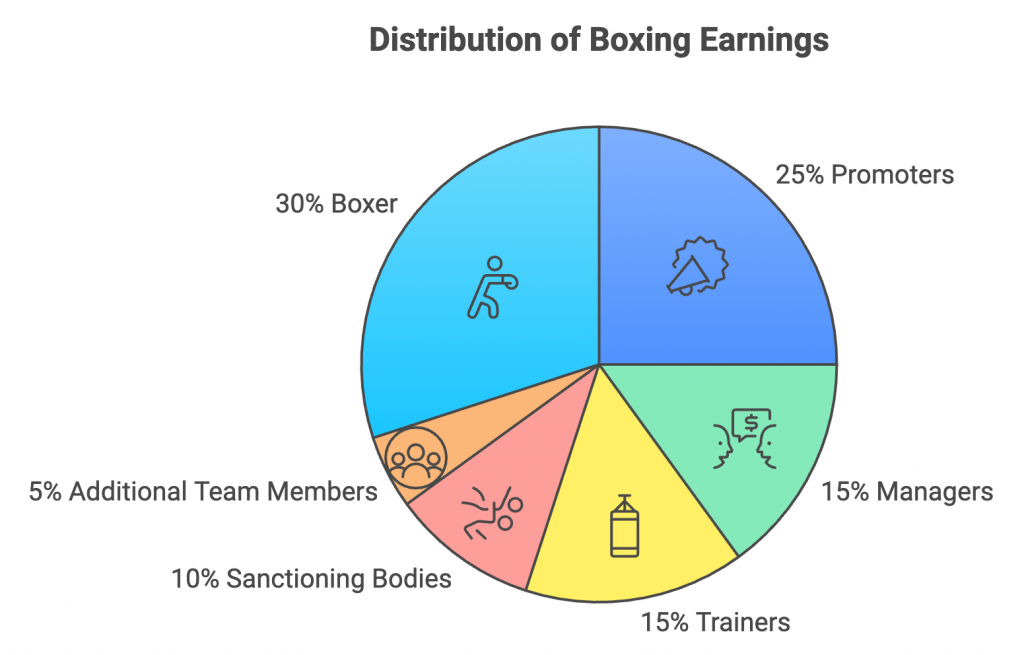How Much Do Professional Boxers Earn
Boxing can be one of the most profitable sports, but only for a few. While top-level fighters like Floyd Mayweather and Canelo Álvarez can make millions from a single fight, the truth for most professional boxers is far less lucrative. Professional boxers earn around $8,000 per fight, which can add up to about $64,000 annually if they fight regularly. However, this figure can vary greatly depending on experience, fight record, and promotional deals. Keep reading if you’re curious about the highs and lows of boxing salaries and what factors impact a boxer’s paycheck.
Highlights of the Article
- Professional boxers’ earnings vary significantly based on skill, reputation, and experience.
- Entry-level boxers typically earn between $1,000 and $4,000 per fight.
- The average mid-tier boxer can make about $8,000 per fight.
- Top-tier boxers can earn millions per fight.
- Boxers’ pay depends on the number of fights they have each year.
- World-renowned boxers like Floyd Mayweather have earned upwards of $100 million for a single fight.
- Sponsorships and endorsements can boost income substantially for popular fighters.
- Women boxers typically earn less than men in the same sport.
- A large portion of income for elite boxers can come from brand partnerships and ads.
Average Salary of a Professional Boxer
While the high earnings of boxing’s superstars are well-known, the reality for most fighters is different. For many, the journey starts with earning as little as $1,000 to $4,000 per fight at the lower levels of amateurs. As boxers rise through the ranks, their pay gradually increases. Once they establish themselves, an average professional fighter can expect to earn around $8,000 per bout, leading to an annual income of roughly $64,000—assuming they fight several times a year.

However, these earnings aren’t guaranteed. Pay varies widely depending on the boxer’s popularity, skill level, and promotional opportunities. Boxers may also supplement their income through sponsorships and endorsements. Still, these features are reserved for athletes with a strong fan following.
Earnings of Elite: Who are the Richest Boxers?
At the top of the sport, elite boxers can earn astonishing amounts. Fighters like Floyd Mayweather, Anthony Joshua, and Canelo Álvarez have secured some of the highest paydays in boxing history. For example, Mayweather earned around$100 million per fight at his peak, including massive paydays from matches against Manny Pacquiao and Conor McGregor. Anthony Joshua, one of the most prominent British boxers, earned up to $170 million annually during his peak. Meanwhile, according to Forbes, Canelo Álvarez was worth $94 million in 2020, and his fortune was boosted to $275 million in 2024.
| Boxer | Estimated Net Worth |
|---|---|
| Floyd Mayweather | $450 million+ |
| George Foreman | $300 million |
| Manny Pacquiao | $220 million |
| Canelo Álvarez | $180 million |
| Mike Tyson | $10 million |
These elite fighters don’t just rely on their fight earnings. Most of their income comes from sponsorships, endorsement deals, and show fights. Companies like Nike, Under Armour, and Hennessy often sponsor top boxers, offering lucrative contracts. In addition, elite boxers typically participate in exhibition fights or special pay-per-view events, which can further boost their earnings.
Factors That Affect a Boxer’s Earnings
How much money a professional boxer can make? It depends on several factors, indicated below:
- Fight Record. A boxer’s win-loss record greatly affects how much they earn. Fighters with undefeated or impressive records tend to draw larger crowds, leading to higher payouts. The more wins a boxer accumulates, especially in high-profile matches, the more marketable they become, directly impacting their earnings.
- Boxer Category (Champions, Contenders, Opponents). Boxers fall into different categories, and these greatly influence their earnings. Champions are at the top of the pay scale, drawing the most attention, and frequently headline major events. Contenders, who are on their way up, make decent money but usually far less than champions. Opponents, often brought in to challenge higher-ranked fighters, generally earn the least. Their role is crucial for the sport, but their paychecks are significantly smaller.
- Promoters and Managers. Promoters and managers are vital in negotiating fight contracts and securing the best deals for their fighters. Top promoters, such as Eddie Hearn or Bob Arum, manage high-profile boxers and arrange big fights that can result in multi-million dollar paydays. However, a boxer’s share of the revenue also depends on the fees taken by their managers, who can take up to 20% of their earnings.
- Pre-Fight Negotiations. Fight negotiations are another crucial element. High-level fighters frequently have a say in how much they will earn for a fight, including their base pay and a percentage of pay-per-view revenue. These negotiations can make a significant difference in their overall income. However, the promoters often set the terms for lower-tier fighters, leaving them with little room to negotiate.
- Sponsorships and Entrepreneurship. Boxers who build a solid personal brand typically secure sponsorship deals with major companies. These deals, especially with brands like Nike or energy drink companies, can add millions to their annual earnings. Some fighters, like Floyd Mayweather, venture into entrepreneurship, starting businesses or investments outside boxing to generate additional income. These ventures allow top boxers to maintain their wealth even after they retire from the ring.

Additional Sources of Income
Biggest Payouts in Boxing History
Some boxing matches have generated record-breaking payouts, with fighters earning astronomical sums for just one night in the ring. The biggest example of this is Floyd Mayweather’s legendary bout against Manny Pacquiao in 2015. Billed as the “Fight of the Century,” this fight brought in a staggering $250 million for Mayweather alone, setting the highest payout in boxing history.
Another high-earning fight for Mayweather was his 2017 match against UFC star Conor McGregor, where he reportedly earned around $280 million. These fights are extraordinary for their entertainment value and the enormous sums they generate through pay-per-view sales, sponsorships, and ticket revenue.

Other examples include Canelo Alvarez’s matches, such as his fight against Gennady Golovkin, which netted him millions, and Anthony Joshua’s rematch against Andy Ruiz Jr., where he earned around $70 million. Tyson Fury and Deontay Wilder’s heavyweight bouts also brought in millions, with both fighters walking away with significant paychecks after their epic trilogy of fights.
These figures are far beyond what most boxers will ever earn, but they highlight just how lucrative the sport can be at the highest levels.
How Boxing Earnings Are Distributed
Speaking about the earnings from a boxing match, the fighter doesn’t take home the full amount. Instead, the money is divided among several key parties involved in making the fight happen.
- Promoters. Boxing promoters, like Top Rank or Matchroom Boxing, organize the fights, secure venues, handle marketing, and manage the business side of events. In return, they take a significant portion of the fight earnings—usually between 20% and 33% of the fight purse. Promoters are essential to the event, but their cut can dramatically reduce how much a fighter ultimately earns.
- Managers. A boxer’s manager negotiates contracts and ensures their fighter gets the best possible deal. Managers typically take 10% to 20% of a boxer’s earnings, depending on the contract. While they help fighters secure the best paydays, their fees impact the boxer’s take-home pay.
- Trainers are a vital part of a boxer’s success, and they, too, receive a share of the fighter’s earnings. A trainer’s cut frequently ranges from 10% to 20% of the fight purse, depending on the agreement between the fighter and the coach.
- Sanctioning bodies like the WBA, WBC, IBF, and WBO oversee the legitimacy of title fights and award championship belts. These organizations also take a percentage of the fight earnings, particularly when championship titles are on the line. The fees for sanctioning bodies can range from tens to hundreds of thousands of dollars, depending on the importance of the match.
- Additional Team Members. Beyond promoters, managers, and trainers, boxers pay other team members, such as strength and conditioning coaches, nutritionists, sparring partners, and cutmen. These professionals are compensated with either a fixed fee or a small percentage of the earnings, reducing the boxer’s total payout.

Boxers typically take home 50% or less of their fight purse. Even high-level fighters divide their earnings among the large team and support network behind the scenes.
Men vs Women: Who gets paid more?
Women’s boxing has made impressive strides, with fighters like Claressa Shields and Katie Taylor earning up to $1 million for major events. Though these are big numbers, female boxers still earn much less than male counterparts like Floyd Mayweather or Anthony Joshua, who make millions per fight. The gap largely comes from fewer pay-per-view opportunities and less media exposure. However, women’s boxing is gaining traction, especially after its Olympic debut in 2012, helping female fighters grow their fanbase and income.
While progress is visible, the challenges in earning equal pay remain. Women continue pushing boundaries in the sport, and as the audience for women’s boxing grows, so does the possibility of higher earnings, sponsorships, and promotional opportunities. This shift in recognition is essential to paving the way for future generations of female fighters.
Comparison With Other Sports
When comparing boxing earnings with other sports, the financial landscape varies widely. Professional boxers earn more than UFC fighters in combat sports, particularly at the elite level. Top boxers like Floyd Mayweather and Canelo Álvarez have walked away with nine-figure paychecks for a single fight. In contrast, UFC fighters usually make significantly less, even at the top. For instance, Conor McGregor, one of the UFC’s biggest stars, earned around $3 million for his UFC 246 fight against Donald Cerrone—far below what he made fighting Mayweather in their 2017 boxing match.
The difference largely comes down to the business model. Boxing promotions often allow fighters to negotiate bigger slices of pay-per-view and ticket sales revenue. In contrast, UFC fighters typically receive a fixed payout, with limited access to additional earnings from the event.
Boxing paydays are less predictable than other mainstream sports like basketball, football, or baseball. Athletes in sports like the NBA or NFL sign multi-year contracts with guaranteed salaries. For instance, the 12th player on an NBA team can earn a couple of million dollars annually, while even mid-level NFL players secure significant pay over their careers. In boxing, the top 1% of fighters can earn enormous sums. Still, most professional boxers have irregular incomes.
Earnings Comparison Table
| Sport | Average Earnings per Event/Year | Income Stability | Additional Earnings (Sponsorships) | Earnings Growth Potential |
| Boxing (Top Level) | $100M+ per fight | High (for top stars) | Very High | Very High |
| Boxing (Average) | $64K per year | Low | Low | Moderate |
| UFC | $3M per fight (top star) | Moderate | Moderate | Moderate |
| NBA | $2M+ per year (bench player) | High | Very High | High |
| NFL | $860K+ per year (mid-level player) | High | Very High | High |
Conclusion
While boxing offers the potential for life-changing earnings at the highest levels, it’s a sport where only a small fraction of athletes ever see such rewards. Elite fighters like Floyd Mayweather and Canelo Alvarez have made hundreds of millions, but the reality is less attractive for the average professional boxer. Most boxers face financial uncertainty, with modest earnings and many expenses that reduce their take-home pay. Success in boxing depends on a mix of talent, hard work, and, often, the right promotional opportunities. So, the dream of big money is real but remains elusive for the majority.



